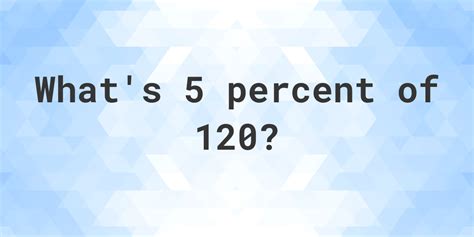What Is 5 Percent Of 120
Kalali
Apr 06, 2025 · 4 min read

Table of Contents
What is 5 Percent of 120? A Comprehensive Guide to Percentages
Calculating percentages is a fundamental skill in many aspects of life, from everyday finances to complex scientific calculations. Understanding how to find a percentage of a number is crucial for budgeting, tipping, understanding discounts, and much more. This in-depth guide will not only answer the question, "What is 5 percent of 120?" but also equip you with the knowledge and strategies to tackle any percentage calculation with confidence.
Understanding Percentages
Before diving into the calculation, let's solidify our understanding of percentages. A percentage is simply a fraction expressed as a part of 100. The symbol "%" represents "per hundred." So, 5% means 5 out of 100, or 5/100.
Key Concepts:
- Percentage: A fraction or ratio expressed as a number out of 100.
- Whole Number: The total amount or quantity you're calculating the percentage of (in our case, 120).
- Part: The result of the percentage calculation (the answer to "What is 5 percent of 120?").
Methods for Calculating 5% of 120
There are several approaches to finding 5% of 120. Let's explore the most common and effective methods:
Method 1: Using the Fraction Method
This method directly translates the percentage into a fraction and then performs the calculation.
- Convert the percentage to a fraction: 5% is equivalent to 5/100.
- Multiply the fraction by the whole number: (5/100) * 120
- Simplify the calculation: You can simplify the fraction before multiplying: (1/20) * 120 = 120/20
- Solve: 120/20 = 6
Therefore, 5% of 120 is 6.
Method 2: Using Decimal Conversion
This method converts the percentage to a decimal and then multiplies it by the whole number.
- Convert the percentage to a decimal: To convert a percentage to a decimal, divide the percentage by 100. 5% / 100 = 0.05
- Multiply the decimal by the whole number: 0.05 * 120 = 6
Therefore, 5% of 120 is 6.
Method 3: Using Proportions
This method utilizes the concept of proportions to solve the percentage problem.
- Set up a proportion: We can set up a proportion: x/120 = 5/100, where 'x' represents the unknown value (5% of 120).
- Cross-multiply: 100x = 5 * 120
- Solve for x: 100x = 600 => x = 600/100 = 6
Therefore, 5% of 120 is 6.
Practical Applications of Percentage Calculations
Understanding percentage calculations is invaluable in numerous real-world scenarios. Let's explore some examples:
1. Sales and Discounts
Imagine a store offering a 5% discount on an item priced at $120. Using our calculations, we know the discount would be $6, making the final price $114.
2. Tipping in Restaurants
Calculating a tip is a common application of percentages. If you want to leave a 5% tip on a $120 restaurant bill, the tip would be $6.
3. Interest Calculations
Understanding percentages is crucial for calculating simple interest on loans or investments. A 5% annual interest on a $120 investment would yield $6 in interest after one year.
4. Tax Calculations
Sales tax is another common example. If the sales tax is 5%, the tax on a $120 purchase would be $6.
5. Grade Calculations
Percentages are frequently used to express grades in academic settings. If a test is worth 120 points and you score 5% of those points, your score would be 6 points.
Advanced Percentage Calculations: Beyond the Basics
While calculating 5% of 120 is straightforward, more complex percentage problems can arise. Let's explore some scenarios requiring more advanced techniques:
Finding the Percentage:
Suppose you scored 6 points out of a possible 120 points on a test. To find the percentage, you'd use the formula: (Part/Whole) * 100. In this case, (6/120) * 100 = 5%.
Finding the Whole Number:
If you know that 5% of a number is 6, and you need to find the original number, you can use the formula: (Part/Percentage) * 100. In this case, (6/5) * 100 = 120.
Percentage Increase or Decrease:
Calculating percentage change involves comparing two values. For example, if a price increased from $100 to $120, the percentage increase is calculated as: ((New Value - Old Value) / Old Value) * 100 = ((120 - 100) / 100) * 100 = 20%.
Tools and Resources for Percentage Calculations
Many online calculators and software programs can assist with percentage calculations. These tools can be incredibly helpful for more complex problems. However, understanding the underlying principles is crucial for effective problem-solving.
Conclusion
This comprehensive guide has thoroughly addressed the question, "What is 5 percent of 120?" We explored various methods for calculating percentages, highlighting their practical applications in everyday life and more complex scenarios. Mastering percentage calculations is a valuable skill that enhances your ability to tackle numerical problems across various fields. Remember, whether you use the fraction method, decimal conversion, or proportions, the core concept remains consistent – understanding how to express percentages as parts of a hundred. Practice makes perfect, so continue practicing these methods to build your proficiency and confidence in tackling percentage calculations.
Latest Posts
Latest Posts
-
32 Oz Is How Many Liters
Apr 09, 2025
-
How Many Seconds Is In 30 Minutes
Apr 09, 2025
-
How Many Cm In 13 5 Inches
Apr 09, 2025
-
Are Convex Lenses Converging Or Diverging
Apr 09, 2025
-
How Many Feet Is 400 Cm
Apr 09, 2025
Related Post
Thank you for visiting our website which covers about What Is 5 Percent Of 120 . We hope the information provided has been useful to you. Feel free to contact us if you have any questions or need further assistance. See you next time and don't miss to bookmark.